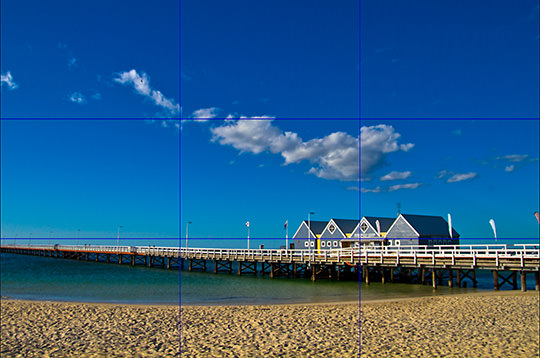”You don’t take a photograph. You make it.” - Ansel Adams. What separates a good photograph from an average one? Several million photographs have probably been taken of popular landmarks through history. Why are some photographs amazing, while others just ordinary? Here are 10 basic tips for any photographer who wants to take their photography skills to the next level. (Reported by: Isaiah Tan)

1) Find a different angle
Many photographers walk around and take photographs at eye-level.
While there’s nothing wrong with doing this, the photographs that stand out are often those with a more interesting angle.
A low angle shot makes the subject more majestic and imposing, while a high angle shot usually has the opposite effect.

An example of a low angle photo with long exposure.
2) Composition – rule of thirds
The rule of thirds is a useful guideline on placement of your subject within the frame.
Most modern digital cameras now have a built-in rule of thirds guide that can be switched on to help framing.
Basically, don’t always place your subject in the centre of the frame. It may be symmetrical, but it can be very boring.
This rule is useful for the placement of the horizon as well.
Remember, this is more a guide than a hard and fast rule.

Follow the rule of thirds for interesting, eye-catching photographs.
3) Use a tripod
If you’re serious about making great photographs, you need a tripod.
A tripod is very useful for landscape photography at night. Increasing your ISO will make your photos grainier.
A tripod allows you to shoot at a slower shutter speed and you will be able to capture more interesting shots and experiment more.
It's also exceptionally useful when you're shooting with your telephoto-lens which is heavy and difficult to keep steady.
4) High Dynamic Range photography
High Dynamic Range (HDR) photographs give a more professional feel to your shots, and the great thing about most of the higher-end Canon EOS DSLR cameras is that they come with HDR modes. You can also achieve HDR photographs manually by snapping multiple exposures with a tripod and merging them together.
Dynamic range is basically just the difference between the lightest light and darkest dark you can capture in a photo.
The results could range from a perfectly exposed high contrast photo, to a surreal, mind-blowing work of art.
To achieve good HDR photos it is recommended you use a camera with Auto Exposure Bracketing. You would also need a good HDR photo-blending software.
5) Get a fast lens
The faster the lens (the lower the f stop), the thinner the depth of field. The depth of field refers to the range of distance that appears acceptably sharp in your photograph. It is often pleasing and interesting to have a narrow depth of field which results in a sharp subject with a blurred foreground and background.
Contrary to popular belief, it is possible to buy a fast lens that does not cost an arm and a leg. You can get some reasonably fast lenses for a great price.
Fast lenses are great for night photography and even photography in general. With a faster lens you can ensure less shakiness with a faster shutter speed, and it is definitely essential in low light conditions.
A fast lens reduces the need for an overly high ISO (which makes photos noisy and grainy), and it is great for isolating a subject from the background.
6) Get a variable Neutral Density (ND) filter (This works well with your fast lens)
I don’t leave home without my variable ND filter.
A variable ND filter is basically an adjustable filter that that reduces or modifies the intensity of all wavelengths or colors of light equally, without any changes in hue of color rendition.
With this useful filter, you can maintain your lens at the widest aperture with a slow shutter speed in bright daylight.
It’s great for that dreamy, misty waterfall shot in bright daylight, or that longer traffic streak shot at night.
A variable ND filter also makes it very easy to adjust your exposure in quickly changing light conditions.
7) Get a macro lens
A macro lens is a lens that allows you to take extreme close-up photographs, usually of very small objects.
It is almost like looking through a microscope. Not only is this fun, but it is often astounding what you can see through a macro lens.
You will need your tripod to take really precise macro photography, because it is going to be difficult to focus and the subject is usually extremely small.
If you can’t afford a macro lens, try looking for extension tubes or a 500D Close-Up lens. The 500D is a small double-element lens that attaches to the filter threads on your lenses. It’s light-weight, portable and could transform your entire range of lenses into macro-enabled lenses!

An example of what you can achieve with macro photography and narrow depth of field.
8) The golden hour
The golden hour refers to the time just after sunrise or just before sunset. It’s not exactly an hour as it depends on where you are in the world.
During the golden hour, the warm colour of the low sun is often considered desirable as it enhances the colours.
Additionally, because the sunlight travels through a greater depth of atmosphere, the light is more indirect and there is often less harsh contrast.
9) Include some foreground in your photograph
It is often more interesting to include foreground in landscape photographs to add some depth and character to the shot. Sometimes, make the decision to ditch your tripod and just place your camera on the ground.
With a wide-angle lens, you could include the sand, stones or grass in a shot which helps differentiate your photograph from others. It could also make the shot a lot more dramatic.
10) Experiment and have fun
The fun in photography is experimentation. While keeping in mind useful tips and guidelines, don’t be afraid to bend or break the rules. Normally I would recommend doing this after you’ve secured the shot you initially set out to take. To me, there are no rules - everything is a guide, technically or creatively speaking. See the world through your lenses in new and wonderful ways, and enjoy the journey.

A macro shot of a traditional tungsten lightbulb.
*Photos are taken with the EOS 5D Mark II.

A professional videographer with a love for photography, Isaiah runs a video production company, a wedding video/photo business, as well as a small bar in Singapore. He enjoys experimenting with different photographic techniques and always wants to learn and discover more of the world around him.
































